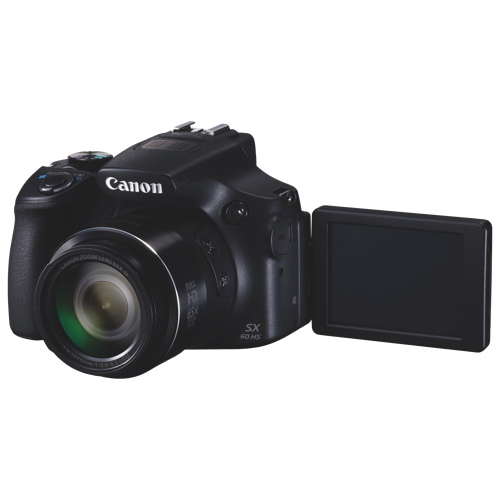 There’s no denying that the 65x zoom on the Canon PowerShot SX60 HS is the headline grabbing feature, and when you use it it will just blow you away. It’s like having a telescope that can also take photographs, and HD video. And the advantage this camera has over a telescope (at least the ones I’ve used) is image stabilisation.
There’s no denying that the 65x zoom on the Canon PowerShot SX60 HS is the headline grabbing feature, and when you use it it will just blow you away. It’s like having a telescope that can also take photographs, and HD video. And the advantage this camera has over a telescope (at least the ones I’ve used) is image stabilisation.
Long Zooms Are Unsteady
The problem with cameras that have long zooms is that it’s very hard to get a steady image. To illustrate this point I use the analogy of the long and short sticks. If I gave you a short stick and asked you to point it straight ahead and keep it steady, you’d probably be able to do a decent job. If I gave you a long stick and the same task however, you would find it much more difficult, because small movements of your arm would get amplified over the length of the stick, to the point where the end would move all over the place.
Image Stabilization
The solution in digital cameras is image stabilization, where the camera intelligently counteracts your movements to allow you to take a sharp image. The zoom on the SX60 however is so long that it’s still a challenge to keep it steady, and it’s quite hard to get your image composed exactly as you want it when your fully zoomed in.
Nevertheless, this is a nature photographer’s dream. You’ll be able to spot birds and marine wildlife from distances that will astonish you.
Small Sensor
Inside the SX60 is a pretty small 1/2.3” sensor, which is about 1/12th the size of the APS-C sensor you’ll find in a Rebel DSLR. This is a limiting factor because it means you can only make small prints from the files the camera produces. It also means that you can’t expect too much in terms of low-light performance. But if you plan to work mainly in daylight and only post images online then this won’t concern you too much.
Pop-up Flash
The SX60 does come with a pop-up flash, so if you are working indoors you can always avail of that. I did notice a couple of interesting things with regard to the flash. Firstly, there is no automatic pop-up mechanism, you have to pull it up manually. I like this because I think the decision to use flash should be a conscious one, not one made by the camera. Secondly, you can choose the timing of the flash so that it fires either just after the shutter opens or just before it closes. This is known as First or Second Curtain Sync, and it only really becomes a useful feature when you shoot at slow shutter speeds, but using Second Curtain Sync allows you to create cool motion trails behind a moving object.
Wi-Fi Enabled
I was really pleased to see that the SX60 is wi-fi enabled, which means that when you load the Canon Camera Window app to your smart device you can connect the camera to your device and instantly pull images from the camera to your phone and share them online. I’ve been using this feature to post images to my instagram account with the hashtag #powershotsx60hs. The other cool thing you can do is get a live feed from the camera to your phone and then remotely trigger the shutter. I had a lot of fun with this feature when I tested the Sony RX100 M3 last year. I didn’t find that the feature actually worked that well on the SX60 however. Whereas on the RX100 the feed was surprisingly ‘real-time’ and the response between pressing the button on the screen and shooting the image was pretty good, I found the feed from the SX60 not that great and I found it was a bit unpredictable in firing. I also assumed I would be able to shoot in manual mode, but unfortunately not; you can only shoot remotely in automatic mode, which I find very limiting. You do have the ability to activate the zoom remotely though
 ‘DSLR-lite’
‘DSLR-lite’
I liked the ergonomics of the SX60. It has a sort of ‘DSLR-lite’ feel with a solid handgrip. The pop-out LCD screen at the back swivels and rotates which is handy, but it’s not touch sensitive. I did a feature a little while back on ‘My Top 5 Cameras For Shooting Video’, and I had that in mind when I was testing the SX60. And indeed this is a good camera for video. A pop-out screen is kind of a must have for video, and the SX60 also allows you to plug in an external mic. A hotshoe on the top means that you can add a LED light source like this one from Bower. The image stabilisation means that you get nice steady video and the zoom motor is really quiet so you won’t notice that on the audio. I was really pleased with the HD videos I was able to capture on Christmas morning and share with the folks back home. The autofocus is really smooth and is very good at picking out faces. Apparently you can manually change some settings while shooting video, but that was beyond my needs.
Weak Features
Canon has tried to incorporate enough features and manual controls to keep the pure photographer happy, although I wasn’t too impressed with the electronic viewfinder. The viewing experience wasn’t great and it just felt struck me as pretty low-grade. You can focus manually, but there are no dedicated controls to let you do so, you have to use buttons instead which I found very slow and tiresome. These were two features that I felt Canon would’ve been better off omitting.
All in all I did enjoy using the PowerShot SX60 HS and I’m sure that if you live around nature and open expanses of water, you’ll enjoy using that monster zoom too. But this is not a camera for the enthusiast or someone who wants to photograph seriously, because unfortunately there are some feature quirks that let the camera down, and honestly the image quality is well below that of an entry-level DSLR.



